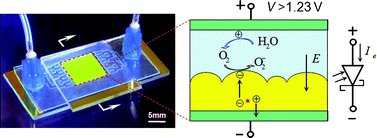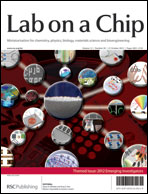Microfluidic photoelectrocatalytic reactors for water purification with an integrated visible-light source†
Abstract
This paper reports experimental studies using the photoelectrocatalytic effect to eliminate a fundamental limit of photocatalysis – the recombination of photo-excited electrons and holes. The fabricated reactor has a planar reaction chamber (10 × 10 × 0.1 mm3), formed by a blank indium tin oxide glass slide, an epoxy spacer and a BiVO4-coated indium tin oxide glass substrate. A blue light-emitting diode panel (emission area 10 × 10 mm2) is mounted on the cover for uniform illumination of the reaction chamber. In the experiment, positive and negative bias potentials were applied across the reaction chamber to suppress the electron/hole recombination and to select either the hole-driven or electron-driven

- This article is part of the themed collection: 2012 Lab on a Chip Emerging Investigators

 Please wait while we load your content...
Please wait while we load your content...